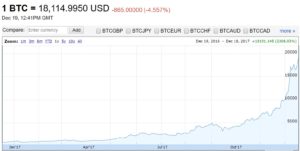I’m trying to build my audience, so if you like this post, please share it on social media using the buttons right above.
Inflation is dead!!! That’s quite a proclamation. Is the stress of the holidays getting to me, making my mind soft? Or is there something really to it?
If you are a regular reader of this column, you know that inflation can have an enormous impact on your financial plan. You also know that I think that the government’s official measure of inflation (CPI) is way overstated. No matter what you think, it’s undeniable that inflation is important and generally the lower the better.
If you don’t want to read the whole column, I’ll give you the answer: robots and engineering. If you’re interested in my reasoning, read on.
Quick Crash Course
Inflation basically comes from one of two places:
- The government going insane and turning the presses on to print more money. This is hyperinflation and Zimbabwe and Venezuela lately and the Weimar Republic in the 1920s are good examples of this.
- The general rise in prices as people demand more for their labor and raw materials get more scarce, leading to increased prices.
Say what you will about the insanity of Washington, but #1 really isn’t a concern. So inflation for the rich countries of the world really comes from #2.
Oil
The latest bout of really bad inflation in the US was in the 1970s and carried over to the early 1980s until Ronald Reagan and Paul Volker punched inflation in the face. That was started by the oil shocks that OPEC imposed on the world.
Oil production was curtailed which drove prices higher. Oil is a bit of a unique commodity in that we used it (and continue to do so although to a lesser degree) in nearly every aspect of life. More on that in a minute. Our world was based on oil so we really couldn’t do with less, so we had to pay more. We really didn’t have a choice. Prices rose (inflation).
Thirty years later in the mid-2000s oil prices dramatically rose again to $150 per barrel as demand from India and China shook the markets. Again we had to use oil so we paid the higher prices, but then that story ended differently. Technology had advanced so we could use less oil—natural gas powerplants, hybrid cars, solar panels, etc.—which took a bite out of the 2007 oil shock.
Also, and more importantly, technology also allowed fracking and oil sands to produce amazing amounts of oil in the US and Canada. All the teeth were taken out of the OPEC threat. Prices cratered over the next few years and have remained at very low levels. If oil ever goes up again, more fracking and shale sands will be mined to bring prices back down. We’re probably set with oil prices being moderately controlled for the next 100 years.
BOLD PREDICTION—Oil prices will never rise faster than 2% for the rest of my lifetime.
Other raw materials
Oil is a very unique raw material in that it is used everywhere. Others aren’t nearly so ubiquitous. That said, raw materials can increase in price. However, when that happens our dynamic economy has shown an amazing ability to engineer products to substitute the more expensive raw materials for cheaper ones.
The price of copper has doubled over the last 30 years (from about $1.50 per pound to $3.00 per pound). That should cause inflation yet think about engineering. Thirty years ago how much copper was used in telephone line—a ton (literally)? Now that’s all fiber-optic cable (mostly plastic—which is cheap) that carries a 1000x information at marginally higher prices. Copper pipes used to be used exclusively in homes. Now it’s PVC which is cheaper and more durable. You get my point.
You can also have commodities like foodstuffs (cows and bushels of corn). In the past those have increased in price significantly. However, as an economist would predict, as the price goes up farmers plant more corn and ranchers husband more cattle. That keeps everything at relatively steady prices.
When ever anything gets more expensive, businesses, with their profit motive, will find alternatives to do the job better at a lower price. That is going to keep a major cap on inflation.
BOLD PREDICTION—There won’t be raw material whose price goes up significantly while also whose use increases significantly.
Robots
The largest component of inflation is human labor. In the past, there has always been a general pull towards higher wages. When the economy is weak (unemployment is high) that tends to slow or even stop. When the economy is strong (unemployment is low) companies have to compete for workers and they do so by raising wages. That leads to higher prices.
Of course, higher prices don’t always translate to inflation. If a person is paid more but is much more productive (thanks to computers or other tools) that doesn’t lead to inflation, and if the productivity improvements are large enough will often lead to deflation.
However, and here’s the political hot potato, those productivity advances tend to be focused on the highest-skill workers. Engineers now have computers to make them more productive; airline pilots have more advanced aircraft; construction workers have better tractors. When most of those people got pay increases it was because they were more productive, no their impact on inflation was minimal.
The low-skill workers really haven’t gotten productivity enhancements, so any pay increases they got typically led to inflation. But look at what has happened to all those low-skill jobs. They have disappeared or are disappearing. You don’t have gas-station attendants and grocery-store baggers anymore. Cashiers are quickly disappearing. Soon waitresses are going to disappear.
Most of the time the extinction of these jobs is because technology (robots) can replace them at a fraction of the cost. Politically and socially this is deep water and we could debate this for hours whether this is good or bad. But from an inflation perspective this is definitely keeping a cap on inflation. If the wage for a low-skill job rises to fast, a robot or computer replaces it at a cost of pennies on the dollar.
Go to your grocery store and see all the self-checkout lines. Each of those used to be manned by a low-skill worker. Now one worker is overseeing 8 lines. Many restaurants have self-order tablets which eliminate the need for waitresses (now you only need servers). Of course countless low-skill factory jobs have been eliminated by robots. You could go on and on.
This puts a huge cap on inflation, leading to much of what we see:
- Stagnant wages for low-skill workers
- Exponential growth of people-replacing machines
- Persistently low inflation.
BOLD PREDICTION—Wages for skilled workers will continue to increase while unskilled workers will decrease. Only a minimum wage will keep wages at the low end up, but that will lead to fewer low-skill jobs available.
The Federal Reserve has said it is baffled by the persistent low inflation in the face of fast economic growth, historically low interest rates, a low unemployment. In the past those three ingredients always led to inflation, something that the Fed is chartered to control. To me it seems like an easy situation to figure out, but I am smarter than a Nobel Prize winner ?.
It’s pretty simple—we aren’t going to have inflation because there are so many amazingly smart (and very well paid) engineers that can find any product (including people) whose prices are rising and replace them with cheaper substitutes.
Like I said before, there are social implications for this which make these issues very gray. However, keeping to the black and white areas, I believe this means inflation will probably remain low for years to come. As an investor that’s GREAT NEWS.







